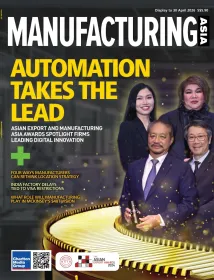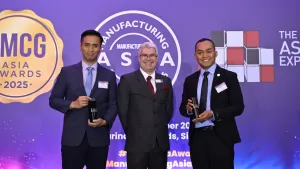
Good supply chain strategy integrates digitalisation – EY’s Atul Chandna
He highlights the need for advanced supply chain strategies and analytics to navigate disruptions and drive future resilience.
With Asia's export and manufacturing industries facing challenges in the rapidly changing environment, companies are seeking solutions to address these issues, boost efficiency, and adapt to the evolving global market.
Offering valuable insights is Atul Chandna, Asia-Pacific Supply Chain Leader at EY, renowned for his experience in advanced supply chain analytics and process consulting and his extensive expertise in sales and supply chain functions across the consumer goods, retail, and chemicals sectors.
His role at EY involves spearheading large-scale turnaround programmes, where he has significantly contributed to business strategy, process re-engineering, and technology architecting for local and multinational clients. Chandna has driven digital supply chain innovation, creating prototypes that utilise robotic process automation, analytics, mobility, and artificial intelligence. He has also led advanced supply chain analytics and process consulting initiatives in Europe and the Asia-Pacific region.
As a judge at the Asian Export Awards 2024 and Manufacturing Asia Awards 2024, Chandna discusses the pressing challenges facing the Asia-Pacific export and manufacturing industries, from geopolitical tensions, regulatory complexities, and technological integration, necessitating advanced supply chain strategies and analytics for resilience and efficiency.
With your extensive experience, what do you consider to be the most significant challenges facing the export and manufacturing industries in the Asia-Pacific region today?
Whilst Asia Pacific has been a global trade hub, geopolitical tensions have intensified supply chain disruptions. These factors have led to delays in production and shipping, shortages of critical components and increased logistics costs. Companies are forced to deal with tariffs, sanctions and shifting trade policies, impacting the stability of business operations.
Another challenge that export and manufacturing industries in the region face is navigating regulatory compliance. Asia-Pacific is a big and diverse region, where each country has its own set of local government regulations. This creates a significant administrative burden and requires investments in legal and compliance teams.
In the past year, we have also observed seismic digital shifts, with smart technologies like artificial intelligence (AI), reshaping the global markets. Yet, these same technologies are challenging businesses. It is complex and costly for companies to integrate them into existing operations, systems, software and hardware, which often have different architectures and protocols. In addition, integrating new technologies will inevitably increase potential security vulnerabilities that companies now have to contend with.
What are the essential components of a robust supply chain strategy that can withstand both minor and major disruptions?
Having an end-to-end visibility is an essential component of a robust supply chain strategy. It involves having real-time insights into every aspect of a company’s supply chain, from the departure of raw materials from suppliers to the delivery of finished products to customers. This can be done by integrating data from across all supply chain touchpoints – suppliers, logistics providers, and internal systems. By continuously monitoring the flow of goods, companies can spot potential bottlenecks before they escalate into major problems.
Another component is diversification. Relying on a single supplier or region leaves a company’s supply chain vulnerable to disruptions. Companies can diversify risks by using different modes of transportation like air, sea or rail, allowing the continued flow of goods even if one of the transport nodes is blocked.
Lastly, a good supply chain strategy is one that integrates digitalisation. Smart technologies like AI, machine learning and predictive analytics help companies anticipate disruptions before they happen, allowing proactive measures. For example, predictive analytics can predict when and where disruptions may occur, and automation can streamline operations, reduce human errors and increase efficiency.
In your opinion, what are the key factors that contribute to a successful large-scale turnaround programme in supply chain management, particularly for multinational clients?
A turnaround programme in global supply chain management is no easy task.
Firstly, companies should do a comprehensive assessment and diagnosis of the current state of the supply chain. This means going beyond surface-level issues and really understanding the root cause of delays, inefficiencies and bottlenecks. The goal is to get a clear understanding of where things stand and identify the critical areas that require attention.
At the same time, there needs to be a strong cross-functional collaboration across departments locally and regionally. Through effective communication and coordination, companies benefit from improved decision-making, enhanced problem-solving and risk reduction. They should also put in place a continuous performance monitoring and improvement system to observe progress.
A turnaround programme should focus on long-term sustainability to reduce risks and enable opportunities for growth. This may involve aligning with diverse environmental and social governance standards across various regions to ensure that the improvements remain sustainable and valuable in the future.
Given the rapid advancement in technologies, how should companies in the export and manufacturing sectors prioritise their investments in these areas to achieve the greatest benefits?
Companies should prioritise investments that maximise impact, enhance efficiency, drive long-term growth and support their strategic priorities.
When investing, companies need to evaluate the urgency of these technologies, and balance innovation with practical considerations, factoring in risk appetite and investment readiness. This allows them to determine the best entry point for technology transformation or adoption. Importantly, technologies that address critical vulnerabilities should be prioritised.
As well, these technologies should be sustainable and have long-term benefits in relation to the business goals. To this, companies should continue to monitor the performance and returns on technology investments and be prepared to adjust their digital transformation strategy as the market changes or as the business evolves. There is no one-size-fits-all solution.
How do you see the role of advanced supply chain analytics evolving soon?
Supply chain analytics is going from reactive to predictive and eventually, prescriptive.
Traditionally, supply chain analytics focussed on reporting past events and diagnosing issues after they occur. This is shifting to be more predictive, enabling companies to anticipate disruptions before they happen, forecast demand with greater accuracy and optimise inventory levels. In the future, prescriptive analytics will take this further by predicting outcomes and recommending the best course of action to achieve desired results.
As supply chains become more complex and customer expectations for responsiveness increase, the need for real-time data analytics will grow. More companies will leverage Internet of Things (IoT) devices to provide immediate data-driven insights to make informed decisions quicker.
Additionally, supply chain analytics will experience personalisation and customisation at scale. This means more dynamic and agile supply chains that are tailored to the specific needs and characteristics of customers across demographics and regions.
As a judge at the Asian Export Awards 2024 and Manufacturing Asia Awards 2024, what qualities or achievements will stand out to you as indicators of excellence in these industries when evaluating the nominees?
I will be looking for nominees who not only excel in their core business functions but are forward-thinking, innovative, committed to excellence and engage in sustainable practices, specifically:
1. Those that have successfully integrated innovative technologies into their operations and have used these tools to transform their manufacturing processes or supply chains.
2. Those that exhibit excellent operational efficiencies, such as a decrease in lead times, cost savings, waste management and reduction, and quality improvement.
3. Those that prioritise customer-centricity. This could be through responsive customer service, personalised or hyper-personalised customer experience or agility in adapting to customer demands and market changes. Those that are customer-centric often have strong brand loyalty and reflect a sustainable growth trajectory.

















